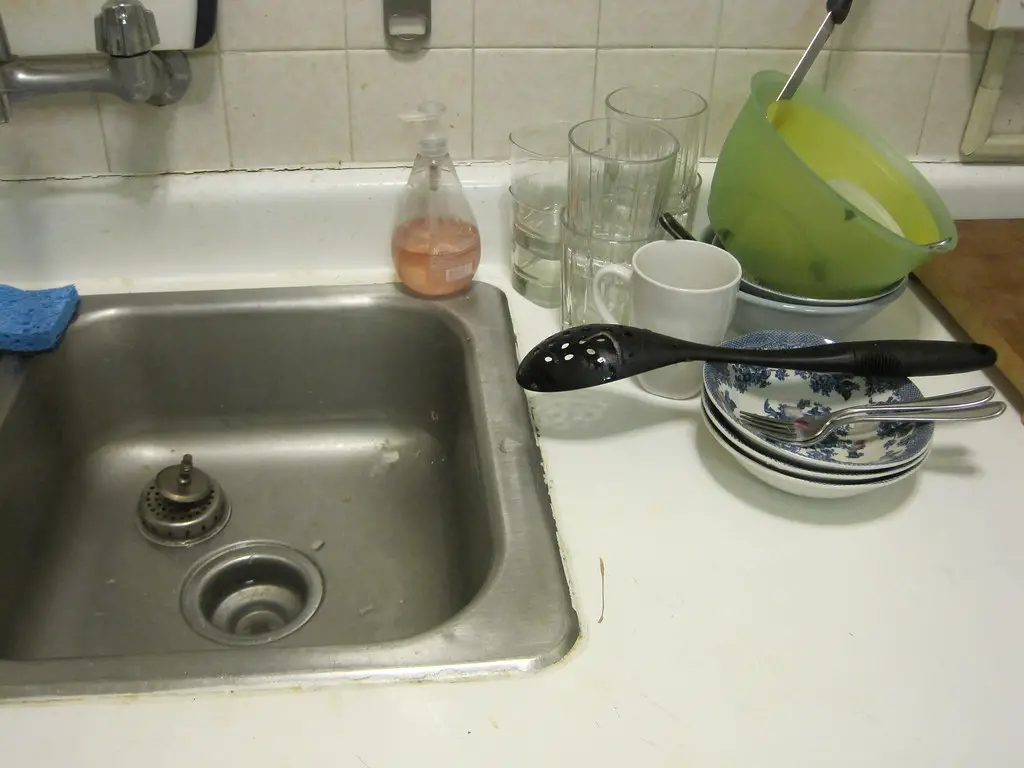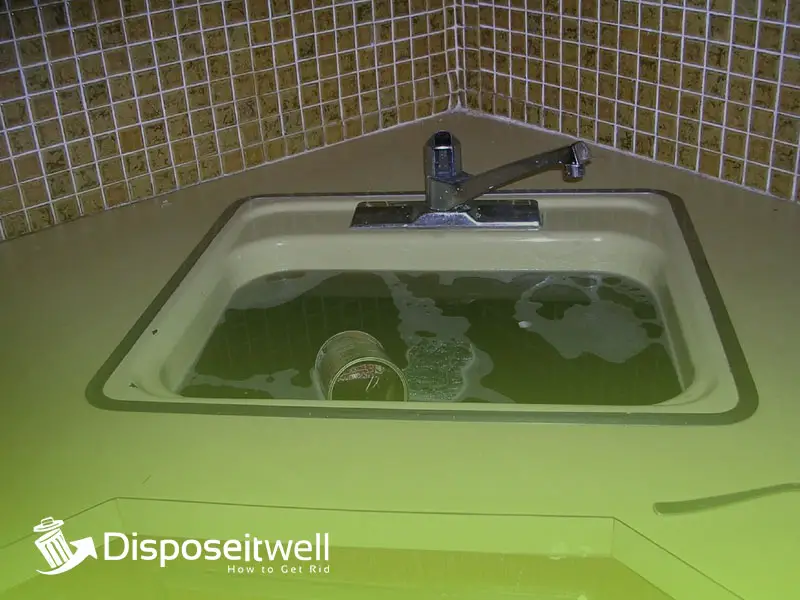From the rancid smell that rises from your kitchen sink to the slow-draining water, a grease-clogged drain can be a source of hassle and frustration. But don’t fear, with the right tools and a few steps, you can easily unclog a grease-clogged drain and restore the flow of clean water.
Unclogging a grease-clogged drain is easy. Start by pouring a pot of boiling water down the drain, then follow up with a cup of baking soda and a cup of white vinegar. Let this solution sit in the drain for 15 minutes, then flush with hot water.
In this article, we will discuss different methods to unclog a grease-clogged drain, so you can get on with your day without any more headaches.
Can You Pour Grease Down the Drain?
No, you should not pour grease down the drain. The City of New York’s Environmental Protection warns that any grease poured down your kitchen sink or drain can cause havoc in the plumbing of your household and throughout the Sewer System. If left unchecked, this grease will slowly accumulate, eventually leading to a full-on clog in the pipes.
Furthermore, when food particles, soap, oil, and grease are poured down the drain, they can accumulate and form a solid blockage. This blockage can cause wastewater to back up and overflow, leading to costly and time-consuming repairs. Additionally, if the grease is poured into a septic system, it can cause the tank to fill up more quickly and require more frequent pumping.
How to tell if your drain got clogged?
Nobody likes it when their drains get clogged up as it can be quite a bother. But the first step to solving this problem is to know how to identify it. Here are a few signs that might indicate your drain is blocked:
1. Slow Draining: This is the most common sign of a clogged drain. If it takes a long time for your sink or shower to empty out, then it is likely that there is a clog in the line.
2. Bad Odors: If a clog is present in your drain, it can cause bad odors to come from the drain. This is due to the buildup of mold, mildew, and bacteria from the water sitting in the drain.
3. Gurgling Sounds: If you hear gurgling noises coming from the drain or toilet, then it could be a sign of a clog. This is because the air is unable to escape through the clog, so it builds up and causes the gurgling sound.
4. Water Backup: If you notice water overflowing from your sink, shower, or toilet, it could be a sign of a clog further down the line. It could cause a backup of water that could lead to more serious issues if left unresolved.
Where did grease come from in the first place?

The grease commonly comes from the following things in the house:
1. Food
Grease can come from many different sources in the kitchen, primarily from animal fats and vegetable oils. Animal fats, like butter, lard, and tallow, are derived from the fat and tissue of animals. Vegetable oils, such as corn oil, olive oil, and canola oil, are extracted from plant seeds. Grease is also created when food is cooked, such as when bacon is fried and fat is rendered from the pork.
2. Soap
Grease is sometimes created when soap is used in the kitchen. This can happen when food is cooked in a pan that has been treated with soap, the residue of which can be left behind. Soap can also be mixed with other ingredients, such as lard or vegetable oil, to make a grease-like substance. This is especially true of soaps made with animal fat. In addition, when soap is used to clean pans and other kitchen items, the residue can also be left behind and accumulate as grease.
How to Unclog a grease-clogged drain
Dealing with a grease-clogged drain can appear to be a challenge. But, there are a few simple and economical methods you can utilize to get your drains running smoothly again, like:
1. Utilize a Common Household Plunger
An effective method to unclog a grease-clogged drain is to use a common household plumber. Plumbers are effective in unclogging the drain because they are able to remove the grease and other debris that has built up in the drain.
To use a plumber, simply attach the plumber to the end of the drain, then use the plunger to push the grease down and away from the drain. After the grease has been removed, the plumber should be replaced and the drain should be flushed with hot water to ensure that all the grease and debris have been removed.
2. Use Chemical Solution
No need to agonize over that grease-clogged drain as a chemical solution is here to the rescue. Simply pour the solution into the drain, let it do its thing for a few minutes, and then flush the drain with hot water. For safety’s sake, don’t forget to don your protective gloves before handling any chemicals. In no time, the clog will be gone and your drain will be running freely again.
3. Use Drain Pipe
If a chemical solution does not work, then another option is to use a drain pipe. A drain pipe is a tool that is specifically designed to remove the grease and other debris that has built up in the drain. To use a drain pipe, simply insert the drain pipe into the drain, and then use the pipe to remove the grease and debris.
4. Baking Soda and Water Method
The final method to unclog a grease-clogged drain is to use a baking soda and water solution. To employ this method, simply mix together a few tablespoons of baking soda with a cup of water and pour the mixture into the drain. Let the mixture sit for a few minutes, then flush the drain with hot water. This solution is effective in breaking down the grease and other debris, allowing them to be flushed out of the drain.
How to prevent grease from blocking your drain again
Drain blockages caused by grease can be a major inconvenience, but they can be prevented with a few simple steps as mentioned below:
1. Use a Drain Trap or Hair Catcher
The first step in preventing grease from blocking your drain is to install a drain trap or hair catcher. These devices are designed to trap grease and other debris that can cause blockages. They are usually made of metal or plastic and can be installed easily beneath the sink.
2. Regularly Clean Your Drains
To keep your drains clear, it is important to clean them regularly. After every use, wipe up any visible grease and food particles that may have accumulated in the drain. Whenever possible, use hot, soapy water and a brush to help loosen the grease and other debris.
3. Pour Boiling Water Down the Drain
Boiling water is a great way to help loosen and dissolve any grease that is stuck in the pipes. Pour boiling water slowly down the drain once a week to help keep it clear and running smoothly.
4. Use Baking Soda and Vinegar
Another effective way to prevent grease from blocking your drain is to use a combination of baking soda and white vinegar. Pour ½ cup of baking soda down the drain, followed by ½ cup of white vinegar. Wait for 15 minutes before flushing the drain with hot water. This mixture helps to break down the grease and other debris that may be causing the blockage.
5. Avoid pouring fats and oils down your drain
Whenever possible, try to avoid pouring fats and oils down the drain. Instead, pour the fats and oils into a container, such as an empty can or jar, and dispose of it in your trash can.
6. Use a Commercial Drain Cleaner
If the above methods are not successful in averting the blockage, then you may need to use a commercial drain cleaner. Follow the instructions on the package and make sure to wear protective gear such as gloves and goggles while doing so.
FAQs
How do you unblock a greasy sink?
To unblock a greasy sink, first try using a plunger to dislodge the obstruction. If the plunger does not work, use a sink auger to clear the blockage.
Turn off the sink’s water supply, insert the auger into the drain, and turn the handle clockwise to force the end of the auger through the clog. Once the obstruction has been cleared, turn the water supply back on. If the clog remains, you may need to call a plumber.
What is the best homemade drain cleaner?
The best homemade drain cleaner is a combination of baking soda, salt, and white vinegar. Start by pouring 1/2 cup of baking soda down the drain, followed by 1/2 cup of salt. Let this mixture sit for 15 minutes. Then, pour 1 cup of white vinegar down the drain and let it sit for another 15 minutes. Finally, flush the drain with boiling water to help clear the clog. This method is effective at unclogging drains because the baking soda and salt create a reaction that helps to break down the clog, while the vinegar helps to dissolve any remaining debris.
Can you snake a grease clog?
Yes, you can snake a grease clog. A pipe snake is a long, flexible metal cable that has a blade on the end. This blade on the end is used to cut through the clog and break it up, allowing the clog to be flushed away. The snake is inserted into the drain and then pushed through the clog until it clears the blockage.
What will dissolve grease in a grease trap?
A grease trap requires regular cleaning and maintenance, and the most common way to do this is to use an enzyme-based cleaner.
Enzyme-based cleaners contain bacteria and enzymes that break down the grease, fats, and oils that accumulate in the trap, allowing them to be washed away in the wastewater. Plus, a small amount of dish soap can be added to the trap, as it helps to break up the grease and make it easier to remove.
Final Verdict
So there you have it, a few simple steps to get your clogged drain flowing freely again. Taking just a few minutes to uncover and apply the right method can make all the difference in restoring your plumbing and avoiding a messy and expensive plumbing bill.
Make sure to use proper safety measures and always be sure to contact a professional if you are in doubt.
Good luck and happy plumbing!
My name is Ella Vicedomine and I’m the founder of this blog. The aim is to start this informational blog to guide people on how to dispose of waste things around in the house but in the right way.


1 thought on “How to Unclog a Grease Clogged Drain”